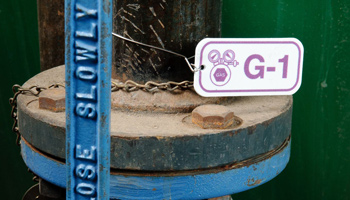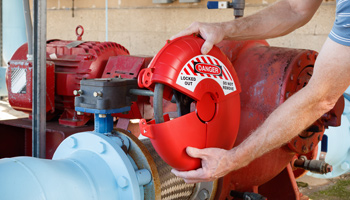Labels for Safety, Visuals and Facility ID Desktop Printers
Labels for Product, Wire and Lab ID Benchtop Printers
Labels for Safety, Visuals and Facility ID Desktop Printers
Labels for Product, Wire and Lab ID Benchtop Printers
Safety and Facility ID Desktop Printers
Product, Wire and Lab ID Benchtop Printers
Barcode Scanner and Printer Kits
Barcode Scanner and Printer Kits
PaintStripe Floor Marking Stencils
Valve Lockouts & Hose Lockouts
Group Lock Boxes & Permit Control
Brady Safety Lockout Tagout Services
Pipe Marker Accessories & Mounting Brackets
Maintenance and Production Tags
Calculators and Assessment Tools
Product Finders and Data Sheets
Valve tags are the silent heroes of your facility. They're not just “nice-to-haves” – they're a critical line of defense against costly confusion, accidents and downtime. Whether you're running a massive plant or a small operation, using valve tags correctly shifts the safety and maintenance landscape from guesswork to informed decision making.
Valve tags do a lot more than you might think. They help with:
Are you required by OSHA to use valve tags? Not necessarily. However, there are several OSHA standards that indirectly make the case for clear valve identification through tagging. For example, OSHA CFR 1910.147(c)(4)(ii)(B) states employers are responsible for “Specific procedural steps for shutting down, isolating, blocking and securing machines or equipment to control hazardous energy.” Valve labeling can play an important role in helping employees execute these steps. And in general, valve labeling is recommended as best practice in any environment where worker safety can be jeopardized by pipe contents.
Now, there isn't a specific set of valve tagging standards. But, they are most often tied to guidelines for pipe marking. Specifically, the ASME (ANSI) A13.1 Scheme for Identification of Pipe Systems. This color-coded system is designed to let people know what's flowing through a pipe at a glance.
For instance, if you see a red tag with white letters, that's your cue for fire-quenching fluids. Orange with black letters? Watch out for toxic or corrosive liquids. Yellow with black letters means flammable or oxidizing fluids. Brown with white letters indicates combustible fluids. Green with white letters is for water and blue with white letters is for compressed air.
| Label Color | Text Color | Color | Pipe Contents |
|---|---|---|---|
| Red | White | Fire-quenching fluids | |
| Orange | Black | Toxic and corrosive fluids | |
| Yellow | Black | Flammable and oxidizing fluids | |
| Brown | White | Combustible fluids | |
| Green | White | Potable, cooling, boiler feed and other water | |
| Blue | White | Compressed air | |
| Purple Gray Black |
White | 
|
Defined by user |
| White | Black | Defined by user |
Other organizations offer guidelines on valve tagging for specific industries, including:
Valve tags aren't universal. They should be selected carefully by material and populated with information to denote important identifying information about the valve. Here are a few types and applications where valve tags are used.

Tags designed for water systems may include information on temperature, pressure or flow direction.

Tags for chemical pipes may identify the specific chemical, its hazards (e.g., corrosive, flammable) and appropriate safety measures.

Tags for gas systems should denote the type of gas, pressure and any potential hazards (e.g., asphyxiation, flammability).

These tags identify the energy source (e.g., steam, electricity, pneumatic) by letter, color and number. As part of lockout best practices, they are tied to steps in a lockout procedure for safer, faster execution of lockout tagout.

Lockout tags can be affixed to a valve to indicate it’s in the off position and should not be operated during maintenance or repair.
Choosing the right material for valve tags depends on conditions, including pipe contents, environment and more. Regulations may also play a role, specifically in the food and beverage industry, where metal-detectable materials must be used in production areas. The most common material types include the following.

Renowned for its durability, brass excels in harsh environments where extreme temperatures, pressure or abrasion are common. It's a top choice for industrial settings, marine applications and anywhere longevity is paramount.

If corrosion is a concern, stainless steel is your go-to. Its resistance to rust and chemicals makes it perfect for outdoor applications, chemical processing plants and facilities with washdown procedures.

For general-purpose use in milder environments, aluminum strikes a balance between durability and affordability. It's lightweight and resists corrosion well in most indoor settings.

Plastic tags are budget-friendly and offer excellent versatility. They're suitable for many indoor applications, can be easily affixed with labels printed with custom information, and come in a range of colors for easy identification.
Like any safety and facility identification measures, what good is a valve tag if you can't see it? Proper placement is key to making sure valve tags do their job.

Valve tags and pipe markers work together to form a comprehensive identification system. While pipe markers provide a broad overview of a piping system’s contents and flow direction, valve tags can detail functions, potential hazards and operational instructions. The result is a safer, more efficient environment where the risk of accidents due to misidentification is significantly reduced.
Valve tags play a pivotal role in lockout tagout procedures in the form of energy source tags. These tags are affixed to the valves required to stop and isolate energy as part of a lockout procedure. Using best practices and visual procedures, energy source tags are color-coded, numbered and cross-referenced in procedure steps to ensure faster safer lockout execution.
When it comes time to lock out a valve, specialized devices are applied to physically prevent the valve from being operated while locked out, including

Valve tagging is put into practice — and not — at countless facilities around the world. Let's take a look at hypothetical examples of what this might look like.
Acme Chemical Processing, a mid-sized chemical manufacturer, understands the critical role of valve tagging in maintaining a safe and efficient operation.
How Acme Chemical Processing applies valve tags
The benefits for Acme are numerous, including:
Old-Way Industries, a manufacturing plant, relies on a mix of faded handwritten labels, inconsistent color codes and passed-down institutional knowledge.
The consequences of poor valve labeling at Old-Way Industries have included:
Brady offers a wide array of products and assistance to help complete any valve labeling program.
Our extensive selection of valve tags caters to every need, from durable stainless steel tags for harsh environments to customizable options that work with any program. Choose from a variety of colors, sizes and materials to create a clear and consistent identification system throughout your facility.

Safeguard your workers with our comprehensive range of valve lockout devices. We offer lockouts designed for every type of valve, ensuring secure isolation during maintenance and preventing accidental energy release.

Complement your valve tags with durable pipe markers that clearly identify the contents and flow direction of your piping systems. From self-adhesive to snap-on, high temperature to chemical resistant, find the marker you need that complies with the (ASME) ANSI A13.1 standard

Produce high-quality, custom valve tags and pipe markers on demand with our reliable and easy-to-use valve tag and pipe marking printers. Our printers are compatible with a variety of materials, enabling you to create tags that withstand even the toughest conditions.

At Brady, we understand that effective valve tagging methods involves more than just products. Our team of experts is ready to guide you through the process, from assessing your current needs to developing a tailored tagging program that meets your specific requirements. Contact us today.
Don’t worry. Experimenting is part of the process.